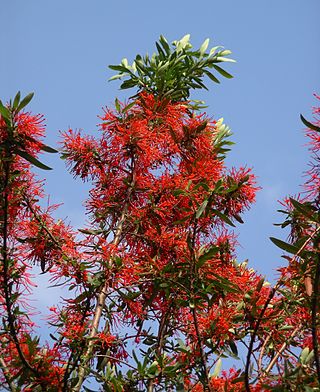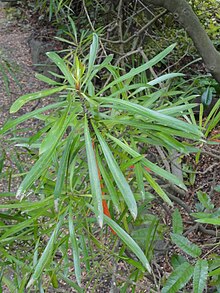
Knightia is a small genus of the family Proteaceae endemic to New Zealand, named in honor of Thomas Andrew Knight. One extant species, K. excelsa (rewarewa) is found in New Zealand. Two further Knightia species are found in New Caledonia, although they were placed in the genus Eucarpha by Lawrie Johnson and Barbara Briggs in their influential 1975 monograph "On the Proteaceae: the evolution and classification of a southern family", a placement supported in a 2006 classification of the Proteaceae. A fossil species from upper Miocene deposits in Kaikorai has been described as Knightia oblonga. Knightia has been placed in the tribe Roupaleae of the subfamily Grevilleoideae.

Persoonia, commonly known as geebungs or snottygobbles, is a genus of about one hundred species of flowering plants in the family Proteaceae. Plants in the genus Persoonia are shrubs or small trees usually with smooth bark, simple leaves and usually yellow flowers arranged along a raceme, each flower with a leaf or scale leaf at the base. The fruit is a drupe.

Xylomelum is a genus of six species of flowering plants, often commonly known as woody pears, in the family Proteaceae and are endemic to Australia. Plants in this genus are tall shrubs or small trees with leaves arranged in opposite pairs, relatively small flowers arranged in spike-like groups, and the fruit a woody, more or less pear-shaped follicle.

Lomatia is a genus of 12 species of evergreen flowering plants in the protea family Proteaceae. Within the family, they have been placed, alone, in their own subtribe, Lomatiinae according to Johnson & Briggs 1975 classification of the family and subsequently in Flora of Australia (1995).

Conospermum is a genus of about 50 species in the family Proteaceae that are endemic to Australia. Members of the genus are known as smokebushes - from a distance, their wispy heads of blue or grey flowers resemble puffs of smoke. They have an unusual pollination method that sometimes leads to the death of visiting insects. They are found in all Australian states, though most occur only in Western Australia. Smokebushes are rarely cultivated, though the flowers of several Western Australian species are harvested for the cut flower industry.

Floydia is a monotypic genus of plants in the macadamia family Proteaceae which is endemic to Australia. The sole described species is Floydia praealta, commonly known as the ball nut. It is a somewhat rare tree found only growing in the rainforests of southeastern Queensland and northeastern New South Wales. The tree has a superficial resemblance to the closely related Macadamia and could be confused with them. The fruit of F. praealta is poisonous.

Embothrium is a genus of two to eight species in the plant family Proteaceae, native to southern South America, in Chile and adjacent western Argentina; the genus occurs as far south as Tierra del Fuego. Common names include Chilean firebush in English, notro in Argentina, ciruelillo, fosforito or notro chileno in Chilean Spanish.

The Proteaceae form a family of flowering plants predominantly distributed in the Southern Hemisphere. The family comprises 83 genera with about 1,660 known species. Australia and South Africa have the greatest concentrations of diversity. Together with the Platanaceae, Nelumbonaceae and in the recent APG IV system the Sabiaceae, they make up the order Proteales. Well-known 'Proteaceae genera include Protea, Banksia, Embothrium, Grevillea, Hakea and Macadamia. Species such as the New South Wales waratah, king protea, and various species of Banksia, Grevillea, and Leucadendron are popular cut flowers. The nuts of Macadamia integrifolia are widely grown commercially and consumed, as are those of Gevuina avellana on a smaller scale.

The Grevilleoideae are a subfamily of the plant family Proteaceae. Mainly restricted to the Southern Hemisphere, it contains around 46 genera and about 950 species. Genera include Banksia, Grevillea, and Macadamia.
Triunia is a genus of medium to tall shrubs or small trees found as understorey plants in rainforests of eastern Australia. Members of the plant family Proteaceae, they are notable for their poisonous fleshy fruits or drupes. Only one species, T. youngiana, is commonly seen in cultivation.

Buckinghamia is a genus of only two known species of trees, belonging to the plant family Proteaceae. They are endemic to the rainforests of the wet tropics region of north eastern Queensland, Australia. The ivory curl flower, B. celsissima, is the well known, popular and widely cultivated species in gardens and parks, in eastern and southern mainland Australia, and additionally as street trees north from about Brisbane. The second species, B. ferruginiflora, was only recently described in 1988.

Roupala is a Neotropical genus of woody shrubs and trees in the plant family Proteaceae. Its 34 species are generally found in forests from sea level to 4000 m altitude from Mexico to Argentina.

Acidonia microcarpa is a species of shrub in the plant family Proteaceae. It is the only species in the genus Acidonia. It is endemic to the south coast of the Southwest Botanic Province of Western Australia.
On the Proteaceae: The Evolution and Classification of a Southern Family is a highly influential monograph on the evolution, biogeography and taxonomy of the flowering plant family Proteaceae. Authored by Lawrie Johnson and Barbara Briggs, it appeared in Volume 70 of Botanical Journal of the Linnean Society in 1975. Johnson and Briggs had presented what would become the paper at a meeting of the Linnaean Society on 6 December 1973 amid celebrations of 200 years since the birth of Robert Brown.

Cenarrhenes is a monytypic genus in the family Proteaceae containing the single species Cenarrhenes nitida, known as the Port Arthur plum or native plum. Cenarrhenes nitida is an evergreen shrub to small tree endemic to the rainforests and scrublands of western Tasmania. It bears white flowers in late spring followed by the development of fleshy fruit.
Hollandaea is a small genus of plants in the family Proteaceae containing four species of Australian rainforest trees. All four species are endemic to restricted areas of the Wet Tropics of northeast Queensland.

Placospermum is a genus of a single species of large trees, constituting part of the plant family Proteaceae. The species Placospermum coriaceum is endemic to the rainforests of the wet tropics region of northeastern Queensland, Australia. Common names include rose silky oak and plate-seeded oak.
Eucarpha is a genus of flowering plant of the family Proteaceae, endemic to New Caledonia. Two species are recognised. Up to 1975, these were classified within the genus Knightia until Lawrence Johnson and Barbara G. Briggs recognised their distinctness, particularly their prominent bracts, in their 1975 monograph "On the Proteaceae: the evolution and classification of a southern family". Nomenclatural combinations for these two species in the genus Eucarpha were published in 2022.

Garnieria is a monotypic plant genus in the family Proteaceae. Molecular hylogenetic studies indicate that it is nested in the larger Australian genus Persoonia where it may be included. It is endemic to New Caledonia where the type specimen was collected at Prony Bay in 1868–1870 by Benjamin Balansa. The only species is Garnieria spathulifolia.
Eucarpha deplanchei is a species of flowering plant in the family Proteaceae, native to New Caledonia. It was first described in 1865 as Knightia deplanchei.















